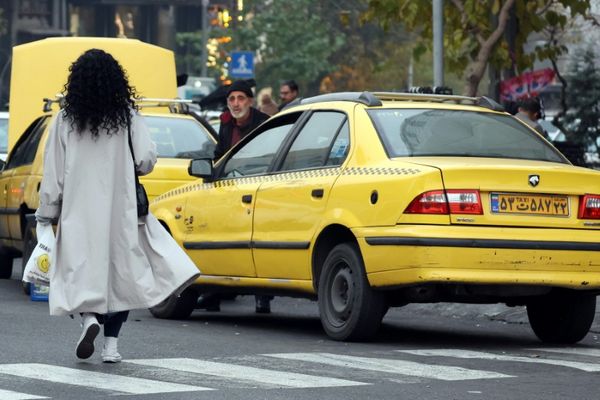
I was trembling. Not because I was about to do something risky or scary – quite the opposite. This was a situation I had been in many times before, but I was nervous about what was going to happen next.
I was on the Concert Hall stage at the Sydney Opera House looking at an audience of about 2,000 people. Not to perform music, thankfully. I’d been invited to speak about why Australia should abolish its private schools. Typical symptoms of performance anxiety include dry mouth, sweaty hands, trembling knees and racing heartbeat – I experienced all these and more. Even my vision had changed thanks to the bright spotlights turned towards me.
Standing alone, I caught sight of the beautiful white birch panelling of the Concert Hall’s interior. It reminded me of my home country. For the Finns, the birch is a sacred tree. Birch trees play an important part in the Kalevala, the Finnish national epic.
Suddenly I felt more comfortable.
It was time to do what I’d come to do – to tell the audience why Finnish parents don’t ever need to worry about finding a good school or paying for their children’s education, and why Australians wouldn’t need to do so either if they didn’t want to.
Imagine that.
This episode happened in September 2012 during my second visit to Australia. I’d enjoyed many conversations and debates with Australians over the years, but that day at the Opera House became my most memorable public talk to that point. It still is the highlight of my working life.
Six years later I returned to Sydney with my wife, our two young boys and six large suitcases. Sydney would be our next hometown after living in Finland, Croatia, Italy and the US. Our boys had gone to kindergarten in Helsinki and both my wife and I worked on education issues in Finland and internationally.
You may consider us an education family.
We certainly considered our new home to be an education nation. Its schools and teachers are admired by students and educators overseas, and I had met scores of Australians who speak to and teach others about education and how to make it better. Not so long ago, Australian education was highly ranked internationally. But that is not so any longer. One reason I had moved to Sydney was to join a group of colleagues and educators to figure out how to fix that situation.
The first thing my wife and I realised was that there is a wide range of all sorts of schools, especially in Australia’s urban areas, so that parents can choose the right one. As a newly arrived family, our first task was to find schools for our boys: a primary school for our older son and a preschool for the younger. Back home the solution would have been a no-brainer: the nearest neighbourhood school or kindergarten in Helsinki. Private schools don’t exist in Finland: most children attend their nearest public school. Which means that parents never pay for their children’s school education, never drive their kids to school nor pack lunchboxes every morning while worrying whether they can provide enough good food to keep their kids going through the day.

In Sydney, everything was different. Most early childhood education providers in our neighbourhood promised innovative programs to teach early reading and maths so that our son would be prepared and ready to go to kindy at the age of five, whereas in Helsinki, children in early childhood education are allowed to develop and learn at their own pace and start primary school at the age of seven. Finnish schools are expected to be ready to welcome all children as they are rather than expecting them to be ready for school.
The price of what was on offer in Sydney was far beyond what we could afford. Daily fees for early childhood education and care were about the same as we’d paid in Helsinki for a month. And so we did what so many other Australian parents do – wait a year until the public kindy would become an option for our youngest boy.
Australian public primary schools still serve families and children in their own communities. As in Finland, Australian children have the right to attend a public school in their own neighbourhood. But things are changing thanks to evolving supplies and demands. Today over 30% of Australia’s primary school children choose not to use that right, instead attending one of the many independent schools that are increasingly available – especially in cities and larger towns.
“Which school did you choose for your boys?” So many new colleagues and friends asked me this before we had even arrived. Given that I think school is an essential part of building a strong and cohesive local community, our boys attend the local public school. Sometimes I tell those curious about this that I am doing a social experiment with my own children by sending them to a public school in Sydney and then writing a piece about it. But frankly, I don’t need further evidence to know the public school down the road is the best option for my boys.
The problem with choice
In pursuit of excellence, an odd dogma has become common in Australian education policy across the past two decades: if education could only act more like a marketplace, excellence would prevail.
Emphasis on school choice and the subsequent competition between schools isn’t a homegrown Australian idea; it’s been influenced by the global education reform movement dominant in the UK and the US since the 1990s. But it seems like Australia has stronger faith in the power of a marketplace than many other countries. Public policies at federal and state levels encourage parental choice in pursuit of individual educational excellence by offering attractive financial support to non-government schools.
Go figure. During the past decade, according to the 2021 Report on Government Services, combined commonwealth and state government funding for private schools increased by more than six times that for public schools. At the same time, private school fees have tripled since 2000. As a result, the proportion of students in government schools has declined and the independent school sector has been slowly growing.
Everybody wants to be excellent. Schools pursue excellence, and parents seek excellent education for their children. Consumers in the marketplace are happy when they get bang for their buck. The 2021 Australia Talks National Survey found that 92% of parents at independent schools were satisfied with the education their child was receiving. And yet research shows that public schools do as well as private schools after differences in students’ socioeconomic backgrounds are considered.
But happy clientele in the education marketplace doesn’t guarantee a good education for every child. The cost of the pursuit of individual excellence in Australian education – rather than a systemic excellence that would provide high-quality education for all – has been gradually eroding equity of education. As is often reported, many international organisations, including Unicef and the OECD, rate Australian education as unequal and highly segregated, leaving too many children behind. At the same time, the overall average performance of Australian students compared with their peers in other countries has been slipping during the past two decades.
When colleagues overseas ask what I think about Australia’s school system, I tell them that it does offer world-class education, but not for everyone. I have seen thousands of schools around the world. But some of the best schools I’ve found are here.
Why, then, is our educational performance not what it used to be just two decades ago? The main problem, as I see it, is neither curriculum, quality of teachers nor leadership in schools. It lies elsewhere. And understanding that problem is key to better education – not just for some but for the entire nation. To borrow (possibly apocryphal) inspiration from Albert Einstein: if I had an hour to solve Australia’s education problem, I’d spend 55 minutes thinking about the problem and five minutes thinking about solutions. Einstein is also claimed to have said that no problem can be solved from the same consciousness that created it.
In other words, we need a new way of thinking.
We have one of the world’s most examined, researched and reviewed school systems, but when it comes to taking the evidence and respective recommendations seriously, we find ourselves in the same old debates and confrontations over and again. As international experts have reminded Australia’s education system leaders, we have now lost a decade due to inability to learn from ourselves and from others about how to build a more equitable school system for all children.
‘Equity and excellence are inseparable’
Education is a complex social system, and complex systems are not easy to understand. Not necessarily because they are structurally complicated – complex systems often have simple design – but because the interaction between their parts is unpredictable.
Sydney has a concrete example of such simple complexity: the Opera House, which is among the most fascinating buildings of the 20th century. Its ingenuity is in its simplicity, yet it was extremely complex to construct. Look at the Opera House carefully, and you’ll see fundamental design principles inspired by organic nature and experiential character, or form and function: simple complexity. In this respect, the Sydney Opera House and a racing bicycle have one thing in common: remove a part, and it won’t work as it was designed anymore.
As I see it, the Opera House represents a metaphor for a modern education system. The Finnish education system is a Nordic design, with simple and practical form and function. Compared with Australia’s education system, it looks deceptively simple when the core purpose is exposed: the learning, wellbeing and happiness of all children for common good. Many have tried to discover the secret of Finland’s school system, but very few have succeeded. The secret lies in its design.

So let’s start with a design question: what is the leading idea in education system design?
Today two of three Australian schools are public. Alongside these public schools – which cater to over 80% of Indigenous students, disadvantaged children and children with greater special educational needs – a privately managed, fee-charging and largely government-funded school sector has been steadily growing for two decades. From the system design point of view, this hybrid system sees schools operate under a wide range of regulations, funded jointly by parents and two separate levels of government using fiscal arrangements that are hard to understand – even for experienced education-system leaders. In this respect, the Australian school system is an outlier among other advanced nations.
At the outset the Australian education sector looks like a marketplace, evolved on the assumption that parental choice is the best driver of whole-system improvement, just as consumer choice works in a real marketplace by pulling prices down and lifting quality up. Therefore, insisting on parents’ freedom to choose their children’s education facilitates the opening of new kinds of schools and encourages “healthy” competition among schools to better serve families’ diverse individual needs. Market mentality also dominates politicians’ responses to parents’ concerns about quality of education. In January 2020 the then-federal minister of education Dan Tehan urged unhappy parents to “shop around” to ensure they get good value for money.
That Australian educational performance shows no sign of improving despite continuous national recommendations and international advice demonstrates that school systems have a design error that increases inequity across both the public and private schooling sectors. An inconvenient truth is that significant financial resources added to education from both state and federal budgets have not made Australian education any fairer. This is linked to the second dimension of the challenge: the structural problem of Australian education.
Many other education systems suffer from structural failures – I have worked with several governments around the world in this space. Using an international lens offers a comparative perspective that is often helpful. In the big picture Australian education is an outlier also in a sense that schools in different parts of the country are more socially segregated than in most other rich countries. Currently, Australia’s school system concentrates disadvantaged students in disadvantaged schools (that is: where more than half of students come from disadvantaged homes), which has unintended implications for student learning.
Much political and public debate focuses on excellence. And Naplan has been held up as the basic driver of improved educational excellence since 2008, annually testing the basic knowledge of all year 3, 5, 7 and 9 students and linking their scores to public school scorecards through the My School website. Naplan has been researched and reviewed and a constant topic of public and professional debates since its inauguration. And, against initial expectations, research has found convincing domestic and international evidence that too strong a focus on externally determined and narrow academic learning outcomes is associated with deteriorating performance.
What’s lost in these debates is a sharper focus on equity and its linear relationship with excellence.
The main finding is this: there can be no national educational excellence without stronger equity of outcomes. Australia should accept – as many nations acknowledged a decade ago – that equity and excellence are inseparable. What’s surprising is that there are still some people who refuse to accept that educational equity is something to worry about.
It is paramount to understanding the state of education that we see education as a system of interrelated elements. When we fail to see it this way, we often also fail to understand why it doesn’t work as well as it should. Rather than ask whether the system’s design and structure are adequate to produce expected outcomes (say, excellence and equity) when we consider stagnated or declining school systems performance and student learning, we pay attention to those who work on the frontline of schooling – teachers and principals. Perhaps teachers are not prepared to teach well enough? Maybe the curriculum is outdated? What if the problem is that we don’t have enough data about how teachers teach and what students learn? These and other similar questions distract from broader structural aspects that need reform.
Consequently, Australia’s education system has latterly evolved in a piecemeal fashion, with frequent fragmented education reforms adding new layers to the work of schools without removing any unnecessary functions.
Let me be clear. Of course it is necessary to upgrade education by improving its integral parts. We need to fix problems related to the teaching profession, including teachers’ workload, teaching conditions and remuneration. We must redesign curriculum systems so that all Australian children better understand the world around them and their own potential. And high-quality early childhood education and care must be accessible to all children before they go to school. These and other measures are all necessary – but they are not enough to guarantee each and every child a fair go.
‘Fixing Australian education isn’t that difficult’
So if the problem is more about the system’s design and structure than fixing its parts, what should be done next?
First and foremost, we need a genuinely wide and majority consensus (and understanding) that the current structure should be redesigned so that policies and practices can be created to reduce prevalent inequities.
Our complicated hybrid system is an offspring of an inherited colonial education model and a cocktail of more recent and haphazard reforms in the 21st century that were mandated without considering the commonly agreed purpose of schooling.
This is a global phenomenon. When new governments take office, new education reforms often follow. Only states with less politicised education systems and more sustainable political systems – such as Finland – have the luxury of not responding this way. Where education is overly politicised, governments often want to leave their mark by rushing to introduce education reforms without deeper contemplation of their possible side effects.
Instead of making schools better, teachers are asked to do more on top of all their previous duties. Through this, Australian schools have become crowded places – like a Christmas tree decorated to the point that we can’t see the tree anymore.
In principle, fixing Australian education is not that difficult, and there have even been moments in the past when this could have happened.
I first visited Australia in 2012. That February, just minutes before boarding my flight to Melbourne, I received an email from an Australian colleague. Attached was the 300-page document now known as the Gonski review, released to the public that very day. My maiden trip to Australia couldn’t have started more optimistically.
The purpose of that trip was to meet with state and territory education-system leaders, speak to teachers about international trends in education and address politicians at Parliament House in Canberra. The newspaper I bought at Melbourne airport had this headline: “Surplus before schools as Gonski report decries student advantage.” If Australia followed Gonski’s recommendations, I concluded, it would be on a good course towards realising the goals of the Melbourne Declaration on Educational Goals for Young Australians (2008).

A decade has passed since the Gonski review, and its recommendations – never fully implemented – are now part of history. Much of the momentum to make those sorely needed structural changes, especially regarding funding, was watered down by political speculations and ideological confrontations. Education reforms continued to ignore evidence from abroad and research from Australian scholars. Many educators were left disappointed and some remain upset, for good reason. Somehow it feels that we are back to square one.
Disappointment has gradually turned into frustration: is it really true that the Australian education sector can’t be changed? Much of the rest of the world has now chosen different directions and some countries are making early progress, such as Scotland, Sweden and some American states.
Can Australia change course before it’s too late?
The simple solution requires us to stop doing things that are not linked to improved teaching and learning. Keeping consequential school accountability, standardised testing and a narrow focus on academic curriculum in the driver’s seat of education policy is not just unnecessary, it’s also harmful to building the professional trust in teachers and schools that is one condition for moving forward.
More complicated, but equally crucial, is to accomplish bipartisan political consensus on the values and principles upon which school education is based. This includes a shared understanding of the purpose of education and how it serves to create a stronger national sense of “common good”. This is not a radical ask. All high-performing education systems have succeeded not because one side won an ideological confrontation but because all have reached out to one another for agreement. Too often, political decisions fail to address that “common good” in favour of privileges for some.
The need for courage
Back to the Sydney Opera House.
The idea of this place being designed by a Danish architect was hard for many Australians to accept. Construction was an engineering nightmare: nothing like this had been built before. The final cost was more than 10 times the original estimate, and many people thought the whole project was ridiculous and unnecessary. The decade-long political fiasco of its construction almost ruined the original idea of the building, ending with lifelong damage to many relationships and erosion of public trust in bureaucracy and politics. Isn’t this a bit like trying to build a new Australian education system?
We have an alternative education system envisioned in the Alice Springs (Mparntwe) Education Declaration and inspired by the Gonski review but it’s widely rejected and misunderstood. Many seem to believe that this country has such a unique history and culture that restructuring its education system is too complicated. And, just as it happens with arts and design, when politics becomes the main driver of decisions, things begin to go wrong.
Of course, today, the Sydney’s Opera House is a Unesco world heritage site, one of the world’s most famous and admired structures.

The solutions that will fix the Australian education system are within our reach and – unlike the Opera House’s construction budget – do not require more and more financial investment. What is needed, more than money, is the imagination and political courage to implement the bold new ideas that would successfully convert yesterday’s failures into new opportunities for tomorrow. Australia built an Opera House in Sydney that many thought would be impossible. Similarly, we can rebuild a school system that offers good education and a fair go for all.
Transforming Australia’s school education systems is not only mission possible; it’s a moral obligation for a country that calls itself an education nation. Both history and science underscore that trust in teachers as professionals is the way to educational equity and excellence.
That evidence is clear – and the road ahead should be too.
• This is an edited extract from Griffith Review 75: Learning Curves, out now. Pasi Sahlberg is professor of education policy at the University of NSW. He is the author of Finnish Lessons: What the World Can Learn from Educational Change in Finland







